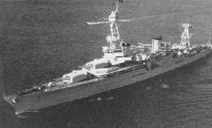On 28th February 1942, HMAS PERTH, a light cruiser, and USS HOUSTON, a heavy cruiser, having survived the Battle of the Java Sea the previous day, stopped briefly in Tanjung Priok, Jakarta’s port, to take on limited supplies of fuel and ammunition, before being ordered to withdraw to the south of Java via the Sunda Strait. Perth, under the command of Captain Hector Waller, and Houston, under the command of Captain Albert Rooks, departed Tanjung Priok at about 1900 hours and sailed at speed, mistakenly believing that the Sunda Strait was being patrolled by Australian corvettes. The only ships in the Strait, however, were the Japanese Western Java Invasion Convoy and its escorts, which included four heavy cruisers, a light cruiser and eleven destroyers.
The first contact was at about 22.30 with the Japanese destroyer Fubuki, which guarded the Eastern approaches, who followed them. At 23:06, when they were about half-way across the mouth of Bantam Bay, Perth sighted a ship about 4.3 nautical miles ahead, near Saint Nicolaas Point, which was initially thought to be an Australian corvette. However, when challenged, the Japanese destroyer Harukaze fired her nine Long Lance torpedoes, fortunately unsuccessfully. At this time, stronger Japanese forces were closing in on the small squadron, but the only result was hits on Japanese warships and none on the Allied ships. This was soon to change. Japanese destroyers fired about 28 torpedoes, none of which hit. The Perth and Houston replied with rapid gunfire and, in the case of Perth, torpedoes, and managed to score several hits on the destroyers, but were themselves also slightly damaged by gunfire. The heavy cruisers Mogami and Mikuma then arrived at the battle. Their 8 inch shells straddled the Perth and Houston and they also fired torpedoes.
At about 23.20, the allied cruisers were out of ammo and now could only hope to reach safer waters by high speed. Japanese torpedoes scored one hit on Perth, later followed by another two. This resulted in heavy loss of life, especially in engineering. Captain Waller ordered ‘abandon ship’, but the Perth received her fourth hit, which was too much for her. She sank at 0025 and took 375 men with her, with only 307 others being saved.
By this time, the Houston had also received several hits, including vital hits. A whole gun salvo hit the aft engine room where the high pressure steam killed almost everyone.
The central fire control system was down along with one of the forward 8 inch-turrets. At about 0020, the last operational turret was hit and Captain Rooks ordered the forward magazines flooded. Without the heavy guns, she now fought with her 5-inch guns and her machineguns. At about 0030, three torpedoes hit the Houston on her starboard side. The water entered the ship from all sides and Rooks ordered ‘abandon ship’. Captain Rooks died when he was hit by a part of a machinegun foundation. The Houston sank and took 698 of its crew with her. Only 368 were taken prisoner.
The Japanese suffer limited damage, with no ships were sunk except those by their own hands: a minesweeper was hit by a torpedo from heavy cruiser Mogami and was blown to pieces, along with a transport ship, the Sakuru Maru. Three other transports were damaged by their own side’s torpedoes. The loss of the Perth was the most major sacrifice made by the Royal Australian Navy during the tragic months of 1941-42 as Japanese forces advanced into south-east Asia
On 17th August 2016, as USNS MERCY passed through the waters of the Sunda Strait where the battle occurred, a joint Australian and American Memorial Service was held to remember the sacrifice made on that fateful night nearly 75 years ago. Nine Royal Australian Navy personnel, supported by their Army and Air Force colleagues from the Australian contingent on Exercise Pacific Partnership 2016, and a US Navy contingent commemorated the events that occurred that night.
Our fourth issue of 2016 primarily addresses the abstracts of papers presented at the 25th AMMA Conference. There are also two excellent articles – one on the role of tele-dermatology in the ADF and the other on the impact of infectious diseases on Pacific island societies. We continue to get a good range of articles, but other military and veterans’ health articles are always very welcome and we would encourage all our readers to consider writing on their areas of military or veterans’ health interest. We would particularly welcome papers based on the presentations at the conference, but welcome any articles across the broader spectrum of military health.


HMAS Perth USS Houston
Dr Andy Robertson, CSC, PSM
Commodore, RANR
Editor-in-Chief






